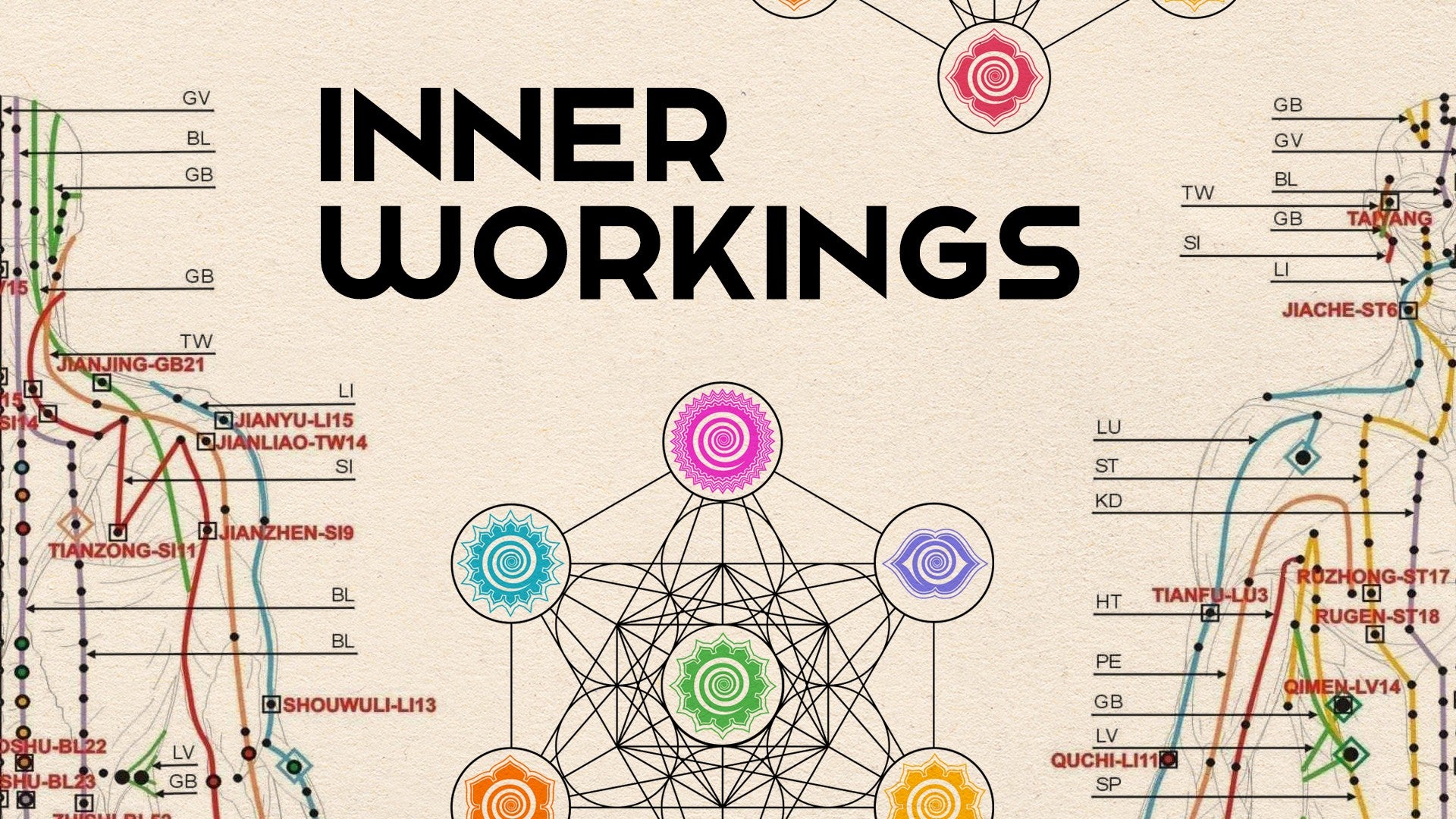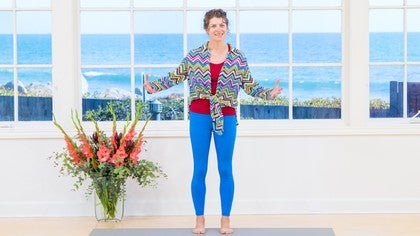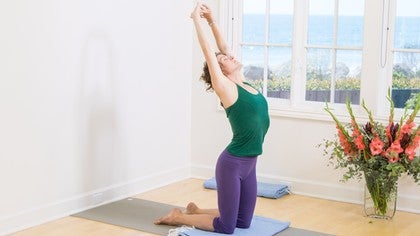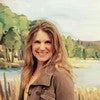Description
About This Video
Transcript
Read Full Transcript
This practice is around the second and third energy centers, Svaristana and Manipura. The first thing we're going to do is just touch them, just hold still for a little bit in my favorite posture, the constructive rest position and let our attention move from our hands into our bodies and from our bodies into our hands and get to know things. So I use blocks to rest my elbows on so that I can actually have my palm really rest on the center itself. You could use a couple books, you might find that you could get the height even better than a block. If you have yoga blocks, use those.
So my elbows are resting on my blocks and I've placed my left palm on Svaristana Chakra, which is just right in the middle of your pelvic bowl, below the navel, above the pubic bone. And my right hand is resting on my solar plexus, Manipura Chakra, above the navel, below the rib cage. My thumb kind of goes up into the symphysis of my ribs and I'm going to hang out. So you're feeling the support of the floor, you're softening into the support of the floor, giving weight, receiving support, and you're feeling with the hands, feeling through your clothing, feeling through the skin, through the layers of muscle, into the organs. You can probably feel your heart beat.
You can definitely feel the swell of the diaphragm as you inhale and it presses down underneath the right hand. You can feel the abdominal muscles performing their eccentric contraction, they're sliding away from each other to allow for the entry of the breath and the descent of the diaphragm. In my body, the breath feels almost like it pushes the two centers gently apart from each other and when I exhale and the breath moves up and out, the centers settle not only down and in, but also toward each other. Now you can think of it as the centers themselves moving or you can feel for a steady sort of emanating light somewhere underneath each palm, maybe a source of heat, maybe it feels like a vibration, that the body moves and dances around. Mostly you're just planting your consciousness.
You could imagine that in the course of the practice that we're going to do together that instead of using your eyes and your face to see where you are and what you're up to with your body, you could use these two centers to orient yourself. Svaristana, deep in the pelvic bowl, center of gravity, source of creativity. Manipura, the side of the stomach, governor of warmth and digestion, transformation. And then we'll come up, so before you take the hands off, you might notice that they're sort of embedded in the flesh now, melted in, connected. So keeping your awareness, deepen your second and third energy centers.
We'll lift the hands away and move the blocks out of the way. And come back to your back, same position, and we're just going to do some pelvic tilting. So you can keep the hands on the two centers if that's helpful for you. You can rest the palms by your sides or just have the hands on the pelvis which is often easier place. And when you inhale, you'll let the contents of the pelvis pour away from you toward the floor between the legs.
When you exhale, you'll let the contents of the pelvis pour toward the navel into the third energy center. So there's a reaching down on the inhalation and receiving upward on the exhalation. Inhale, exhale, and part of what we're feeling for here is the back of the pelvic bowl. So to do work around Svaristana Chakra, we will feel out the whole shape of the pelvic bowl in the same way that we felt for the shape of the pelvic cylinder so that we could connect to Manipura Chakra below Svaristana. So we're just tilting, feeling for the back, the sacrum, the middle of the sacrum, the lower part of the sacrum, the top of the sacrum, and the beginning of the spine.
And then you'll come to neutral. I'm always interested in what neutral feels like after we've been through a movement range. And then we can start the movement range to the sides. So the knees are just going to travel over to the right. And then back to center with the inhalation and over to the left.
If you started with the feet fairly close together, you might find this movement easier if you separate the feet some. It's the inhalation that brings you to center and the exhalation that settles the knees down. And even though it seems like the legs are moving a lot and I'm needing to move the feet in order to accomplish the movement, my awareness is inside the pelvic bowl. And I'm interested in how the weight shifts from the center line over across the iliac arch and into the right side of the bowl. And then again, how it shifts from the right side of the bowl across to the center and into the left side.
We'll just even out here. One more on each side, and then we come to center. And you can pause again, feeling for what neutral feels like left to right. How much effort is required to stay in this position? Is it possible to do less?
And then again, I'll have you shift the knees over to the right, allowing them to travel, allowing the movement to spill up the spine through Manipurachakra. You might feel the ribcage move around. You might even feel the head or the shoulders affected. And then we're going to take the left leg and we're going to start to move the left knee as though we were going to stack it on top of the right knee. And then we'll sweep the left toes over so that the left knee comes even higher than the right knee, closer to the right arm.
And you're making a little bit of a twist here. And the weight is coming even more into the right side of the bowl. There's a good chance that a lot of you will get sensation in the outside of the hip here or into the side of the thigh. And this is one of the places where I'm really interested in our ability to pay attention to the sensations that arise in the various tissues in the body and also touch into the center and relate to the center so that we're not carried away on a tide of sensation and so that we can stay embedded in the wholeness of our experience. So then you can sweep the left foot back where it came from and let the knees tip up.
And we'll go the other way. Knees over, right knee slides up, the toes slide past until the, oh sorry, yeah, until the right knee is higher than the left knee. And then you can pause and soften. Feeling for the weight in the left hip. Is there a particular place in the left side of the pelvic bowl where the weight is particularly concentrated?
Do you have access inside the bowl itself to move the weight around? For me, and actually for several of my students, there's a pinching sensation that happens in the inner hip on one side in postures like this where we're bringing the thigh bone and the lesser trochanter very close to the hip socket. And if you encounter that, I encourage you to explore the ability to make space around the center with the inhalation. That is eccentric contraction inside the pelvic bowl. And then we'll glide the foot back and come back to center and we can pause here again for a second.
We're going to take the left ankle and cross it over the right thigh. You can lift the right thigh toward you some. And then pause for a minute and come down into the contact with the pelvic bowl. And see if you can spread out the tissue that's receiving weight. See if you can do a little eccentric work, expanding and softening the tissue there.
And we'll move the whole package of the legs over to the right so the sole of the left foot comes down. Feeling for the sensation in the left hip, in the left hip socket, maybe in the left outer hip, maybe even in the left low back. Feeling for the center in its relationship to that sensation. Then come back and unfold and recross and gather the left thigh up. So especially in work with the hips, I see students get sort of sensation hungry.
Ah, yeah, it feels good. I want more. I want to feel more. And there's nothing wrong with that unless it takes you away from the breath, from your experience of wholeness. Can you feel the sensation and also feel the pelvic center, Svaristana?
Can you feel, if there's anything happening as you transition the right sole of the foot over to the floor on the left side, is there anything happening in Manipura Chakra? Any pushing one way or the other to accomplish or assist a quality of sensation? Is it necessary? Can you do less? And then we'll come back and uncross.
The last thing we're going to do here is a sort of a full wave. And I find that it's easier to move the push of the feet up through the Iliosaas and into Manipura Chakra if I have the arms out of the way some. So all you're going to do is what you did before where the knees drop. But as they go, as the knees drop, you give a little push and engage with the back foot. So instead of letting the ankle flop and the foot fall away, you're going to find your push pattern, your connection.
And you're going to have that connection rise up through the center body from the pelvic center up to the solar plexus. And then from the solar plexus, you'll fall back and the energy will move back down into the pelvic center and over to the left side. Push and roll, come back, push and roll. So you may at first find yourself sort of accomplishing this, doing what's necessary. Sometimes I find myself really pushing from Manipura Chakra, which feels like a breakage in the connectivity to me.
And gradually you may be able to see my arm is not in the right place. If the arm is up, it's easier. You might find that you can find a connection from the push all the way up. Last one, from the left foot, push and come back. So I want to put the feet up the wall here, you can come over onto your side and scoot closer to your wall.
You're going to have the sitting bones be fairly close to the wall, maybe two or three inches away, so scoot with your hips sideways as close as you want to be and then roll. You can rest the soles of the feet on the wall. We're going to do some abdominal work here at the wall. I want to emphasize that for a lot of us, when we get excited about having something real to do, we have habitual ways of moving around the center that can be hard to experience because something exciting and challenging is happening. So first, just come on up and reach the fingers toward the wall.
The soles of the feet are at the wall. This is a pretty mellow place. You can take a couple of breaths here. When you take your breath, breathe down with the inhalation and just sweep around the money poor chakra, around the third energy center, around the solar plexus. Make it big in there.
Use the diaphragm on the back, on the sides, and on the front to apply some gentle pressure. You can come down and just feel for that. And then we're going to go the other way, so the hands are down by your sides and you can push with the feet a little bit and you're just going to scoop just the pelvis off the floor so the whole bowl of the pelvis comes up off the floor but as near as possible to the ground, so I'm even going to come down a little bit, yeah, so the low back is almost all the way down, the pelvis is up. And then when we go to come down, I'm going to have you breathe all the way out so that with this one, the touch you're reaching for in Svaristana is the out-breath touch, the emptiness, and that's where you're going to get the pressure as you bring the sacrum down to the floor. I'm going to go back and forth that way a couple times.
So you'll inhale up here and exhale and in your exhalation you can find Svaristana and draw it down to the floor, down toward the sacrum, and then with your inhalation, you can puff up all the way around and come down. Press with the feet and exhale, pulling the deep belly toward the sacrum, come on up. So if when you come up, you get the kind of pushed up bulgy feeling in the belly, come on back down and grab your hands like this, why don't we all do it, grab your hands, wrap them across your waist, and draw the sides of the waist toward the center. You can do it down near the pelvic bowl, all the way down by the hips, draw the sides of the waist toward the center, and you can do it up at the ribcage, around the solar plexus, draw the sides of the waist toward the center. So that's the action that's going to happen when you lift up, and when you come down, the transversus, that's what we're feeling for here, is this big band of muscle that goes all the way across this way, so we don't have to overwork with the psoas, we can do the work from the abdominal muscle, that's all going to wrap in.
So the fingers are here, and that's going to stay like that while you're up, but it's not locked down, it's moving, you have to feel the glide so that you can breathe, right? When you come down, but the way that it's moving is this way, into itself and out. So press into the feet, come up, and exhale, pull the seat of the belly toward the sacrum, and down, up, inhale, and down, up, exhale, and down, one more, exhale, and up, exhale, exhale. So now you can stretch the legs up the wall, and for a lot of us that will stretch the hamstrings more, and it may pull the pelvis underneath you more. Just check in and make sure that the weight as much as possible is coming through the leg bones into the sacrum and not into the low back, as much as possible.
And then you're going to make the motion a little bigger, and the arms will reach out behind you, and you'll inhale, and exhale, reach the fingers, fingers toward the wall, and inhale here, and come down, and as the arms go back, the legs will come off the wall and reach toward the fingers. So you're going toward lifting this off the floor, yeah, but you can see how I was very happy to have my arms to help me here. You don't have that because your arms are back here, so you're reaching, and the way you're reaching is not by pushing this up, but by pushing this deep. So you reach, and you come back, and you come up, inhale, fill, come down, arms back, exhale, and back, and legs, and down, and up. Arms back, legs, ooh, that was cheating, very slowly, okay, great.
So we're going to come off the wall. The cheating, what I mean by cheating is that in that very last one, it felt great. I was like, exciting, I'm going to get my toes all the way back there, and it stopped being about this for just a very short period of time, and it started to be about how it was going to look and how it was going to feel, and that's okay. We're not in trouble, but it's worth noticing. That's usually when I get hurt, when it becomes about that instead of about this.
So we're going to come down to the floor and go the other way, here on your belly, cobra pose, tops the feet down, inhale, lift. So one of the things we're exploring here is the way that we pass weight, we pass the gravity in the body back and forth between the centers, and in that little sit-up exercise, we were passing the weight back and forth, and that's what happens here as well. So when I want the chest to lift, what I want to do is transition the weight from Manipura chakra down into Svaristana chakra. So instead of having everything go up, I want to release weight from the upper psoas toward the lower psoas, from Manipura towards Svaristana. So that the psoas can stay supple, and we can kind of teeter-totter it.
So you can exhale the face down and let the legs come up from the pelvic center, from inside the pelvic bowl, radiating to the feet, and then the feet can come down and they can get heavy, and the chest can lift, from the centers, inhaling, exhaling, inhaling, and I switched my fingers to back here, but it doesn't matter, you can do it from here, because really, right, really it's about this, it's right here, in here and in here. Okay, last thing we're going to do, strength training-wise, is some push-ups. This is a little bit of a different way to get into push-ups. The goal is to shift the weight from Svaristana to Manipura so that you can lift yourself up with your arms. So you're going to tuck your toes under and lift your knees up, and then you're going to lift your belly up.
So in the pelvic bowl, you have this from the sides coming to the center all along, and you're just going to move that up until it comes to the heart center, or sorry, to the solar plexus. So this is going to come like this, like this, like this, and gradually it will all come off the floor. Not everybody is going to lift their whole body weight off the floor with their arms today, but getting the zip this way, while the psoas still feels soft and supple and mobile and you still feel like you have a nice open relationship between the two chakras, that's what we're feeling for. So tuck the toes and lift, Svaristana comes up, and then Manipura comes up. Back down, soften, lift, lift from the feet all the way up through Muladhara chakra to Svaristana chakra, and then to Manipura chakra, and down.
And so obviously, once that's all organized, coming up gets to be about the arms. But you can do this from the knees as well. So from the knees up to Svaristana, up to Manipura, and down. I think this is harder. I think it's harder to do it that way, because you don't have the strength, the power of the legs coming through the center, so you can practice.
Okay, come on up, come to your hands and knees, and then bring your elbows down, and we'll interlace the fingers. Okay, a little bit, a little bit more work. So all we're going to do here, these are very small, they're just little glides. You're just going to go forward and back. So with the elbows down, with the hands down, the palms can be down flat, or the fingers can be interlaced.
All you're going to do is glide the two centers forward, and then glide them back. But what I'm interested in, really, is the feeling of passing the energy. So from the lower center to the upper center, and then from the upper center to the lower center. And you may feel it even as a reach all the way through the whole spine, so that going back reaches with the tail, and coming forward reaches with the head. So keep feeling for the relationship between the solar plexus and the pit of the pelvis.
Okay, last one, come back. Now we're going to sit back on the heels here, and have the knees apart, have the hands down. The practice I want to do is called Kapavati. It's a breath practice, and if you've never done it before, you're going to feel a little bit silly, and it's totally fine. All that happens in Kapavati is forceful exhalation.
The inhalation is relaxed and soft. The exhalation is a push from the lower chakras toward the underside of the diaphragm toward Manipur chakra. And it's really up. You're not sucking your belly, and you're just blowing all the air out with your abdominal muscles. And we'll do it together.
So if you've never done this before, feel free to just watch me do it. You can play around. Be gentle with yourself. We're just going to do a couple rounds here. Kapavati means shining skull, and so it can give you kind of a buzzy feeling afterward.
And that's okay. But if you feel out of breath, or if you feel your eyes tighten, if you feel like you're being drawn into your center from your periphery, that's too much. That's stressful for your nervous system. Don't do that. Give yourself a break.
After this, it's all softness. You inhale. The belly's big and soft, big and soft. It won't work unless you really soften the abdominal muscles. And then you exhale quickly.
And that's all. Okay. If you come to like that, look for some more people to train you up. I'm sure there'll be episodes here around pranayams. So now I'm going to go grab my props so that I can make a nice, supported Viparita Karani and Supta Paschimottanasana for us to do.
You'll want a bolster and a blanket and a strap. You'll want to form your strap into a fairly big loop to start. It's easy to make it smaller. And have it ready. And then you're going to put your blanket underneath your bolster.
It'll be maybe about the width of this blanket from the wall, six inches or so. And the bolster's going to go on top. So my blanket is folded so that it's the same width and length as my bolster so that it provides support. Again, you don't have to have exactly these things. You want something nice and soft to meet your low back when your pelvis is up on it.
So just like when you put your legs up the wall, you're going to come at it from the side, sit on it sideways with your back to the wall. And then you just sort of tuck your arm under and roll. I have my strap handy. So it's nice. I have the wall here I can adjust where my pelvis is.
And I'm going to try to have the bolster hit me evenly across my low back. So the whole of my pelvic bowl is resting on the bolster here. And the bolster comes all the way up and supports my low back. And I might scoot back just a little bit. And then I'm going to take my strap and put it around my ankles.
And I'm going to put my hands inside of it so that when my legs are straight and my arms are straight, they're resisting each other somewhat. And then gradually I can just let my arms start to take the weight of my legs. And I get stuck about here. My bolster's not totally even. I'm going to fix it.
I get stuck right around here. And then I'm going to come inside my body and find my two centers. And I'm going to see if I can soften from the center toward the periphery. And I'm using my exhalation to do it. This is not more stretch for my hamstrings.
I'm just releasing from the center to the edge. Okay. So I'm going to bring the legs back up and take the strap off. That's like I could do that for five minutes. So right now what we're going to do is release the legs toward the wall.
This is Viparita Karani. So the wall is supporting the legs. The lumbar spine is supported on the bolster. The weight of the pelvis is supported on the bolster. And the arms can come out by your sides, either up in a cactus position or palms up and down.
And you're just going to stay like this. This is the position that I'm offering for Shavasana. If you're here for a minute or two and you really want to come all the way down and enjoy full contact with the floor, please do that. If you only have a minute or two left in your practice time, then this is a great place to spend those minutes. And if you find yourself really enjoying this shape and you have a chance to be here for longer, this is a wonderful place to hang out, draining the legs into the pelvic bowl, draining the vibrant creative energy in the pelvic bowl into the solar plexus, expanding and softening around the center.
If you've done the Muladhara practice, you may be able to feel the connectivity between the lowest three centers here. But your work here is done. Thank you. If it's your time to come back, then you can join me in sliding the feet down the wall. Roll over to your right side, carefully helping yourself down from your bolster.
Find a comfortable seat. You can draw the hands together or you can bring them again to touch on your second and third energy centers, both infinite and unknowable, and you. Thanks for coming to practice.
Inner Workings: Devon Riley
Comments
You need to be a subscriber to post a comment.
Please Log In or Create an Account to start your free trial.














